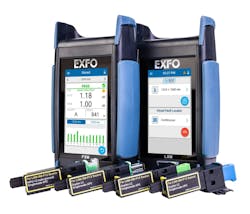EXFO's PXM/LXM Duplex and Multi-Fiber OLTS
|
The new PXM/LXM OLTS is the first and fastest native duplex and multi-fiber loss test set in the industry, delivering Tier-1 certification with loss, polarity, and length measurement in just 1 second. Designed for hyperscale, private, and enterprise networks, the PXM (power meter) and LXM (light source) work together to accelerate fiber deployments and reduce installation errors. BenefitsAccelerate Data Center Network Deployments: The new PXM/LXM enhances operational efficiency, reduces costs, and simplifies the certification process for fiber optic networks. It allows users to measure loss, length, and polarity on duplex and multi-fiber links at two wavelengths within just one second, significantly reducing testing time. This results in substantial savings in both labor costs and operational downtime. Its first-time-right polarity detection for duplex and multi-fiber eliminates hidden errors, ensuring correct fiber connections from the start and avoiding rework delays. Additionally, its patented Click-Out design eliminates the need for multiple devices, making it an essential solution that maximizes return on investment. Lower CAPEX: PXM/LXM supports legacy and next-gen connectors, ensuring seamless integration as network architectures evolve. With PXM/LXM, switch within seconds between duplex and multi-fiber testing with patented Click-Out adapters, compatible with duplex MDC, SN, LC as well as MPO and SYSTIMAX MTP. It also ensures that testers are in the field, as there is no need to send testers back to manufacturer or service center for damaged port change or recalibration. With the click-out solution, users can replace the damaged adapter directly in the field, keeping your tester operational without renewing the calibration and reducing service costs. Industry Standards Assurance: Managing multiple adapter cords slows down testing, increases the risk of errors, and lead to non-compliance with industry standards. EXFO’s Click-Out adapters enable one-cord referencing, eliminating unnecessary cables, reducing handling time, and ensuring fast, error-free testing that fully complies with TIA, ISO, and IEC standards. Source: EXFO |

